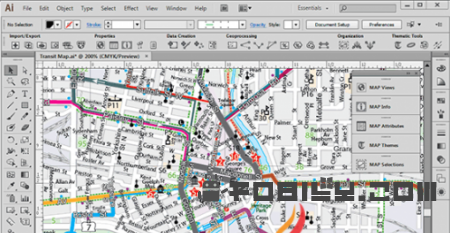

Now, by combining MAPublisher and Add Vertex, users of Adobe Illustrator can easily create map data and share it with the wider GIS and web mapping communities.įrom the MAPublisher Map Views panel, map layers are exportable to many geospatial data formats, including ESRI shapefile, Google KML and KMZ, and AutoCAD DXF. Most cartographers working in Adobe Illustrator and who use the MAPublisher plug-in exclusively import GIS data. Go to Object/Path/Simplify, select the Straight Lines option, and leave the Angle set to 0 degrees, which is the default.īeyond Adobe Illustrator – Sharing your data To remove Bézier curves in Adobe Illustrator, use the native Simplify feature in Illustrator.The georeferencing remains intact, however. With GIS data imported into Illustrator with MAPublisher, applying Add Vertex removes data attributes.The Add Vertex script works slowly on large files with over 1,000 points, requiring patience.Experiment to determine the appropriate spacing of vertices. The spacing between added vertices will vary depending on the size of your map document. Select Add_Vertex.ģ) In the dialog (see below) specify a distance in millimeters. You can also use the Direct Selection Tool to apply the script to partially select ed lines and polygons.Ģ) Go to the File/Scripts drop menu. ( The "en_US" subfolder presumably will have a different name if your are not from the US.)ġ) Open your Illustrator map and select the lines and polygons that you wish to modify. Place "Add_Vertex.js" in the Presets/en_US/Scripts folder.
#ADOBE MAPUBLISHER INSTALL#
To install Add Vertex in Adobe Illustrator CS5 or CS6, on Mac or Windows, do the following:ġ) Download and un-Zip the Add Vertex script.Ģ) Go to the Applications folder (Mac) or Programs folder (Windows) and locate your version of Adobe Illustrator.

The next example shows how A dd Vertex places identical vertices on contiguous polygon borders. If this line were the east-west trending US/Canada border, the extra vertices would allow it to bend southward as it should when mapped in a conic projection. It has ignored the tightly bunched vertices on the left. After you specify the maximum allowed distance between vertices, the script adds vertices only where needed ( B), in this case on the right side. The more vertices placed on a line, the more closely it will approximate the original Bézier curve ( A ).Ī dd V ertex is useful for densifiying lines with variably spaced vertices (see A below). The example below shows a Bézier line with handles in Adobe Illustrator before ( A ) and after ( B ) applying the Add Vertex script, and with the Bézier curves removed ( C ). The intended users of Add Vertex are mapmakers working with GIS data in Adobe Illustrator, coupled with the MAPublisher plug-in.Īdditional vertices are necessary for converting lines drawn with Bézier curves in Adobe Illustrator (see A in the illustration below) to a form useable by GIS programs, which incorrectly interpret these sinuous curves as straight-line segments between the vertices ( B).Īdd Vertex solves this problem. To create it, Savric modified the Divide (length) script by Sato Hiroyuki. It was written by Bojan Savric, Oregon State University, Cartography and Visualization Group.

#ADOBE MAPUBLISHER FREE#
Update: Avenza MAPublisher 9.2.2 now offers functionality (Path Utilities/Add Detail) similar to Add Vertex that maintains attribute data when applied.Īdd Vertex is a free script for Adobe Illustrator that adds vertices (anchor points) to lines and area polygons based on a maximum distance spacing that the user defines. Add Vertex – Script for Adobe Illustrator


 0 kommentar(er)
0 kommentar(er)
